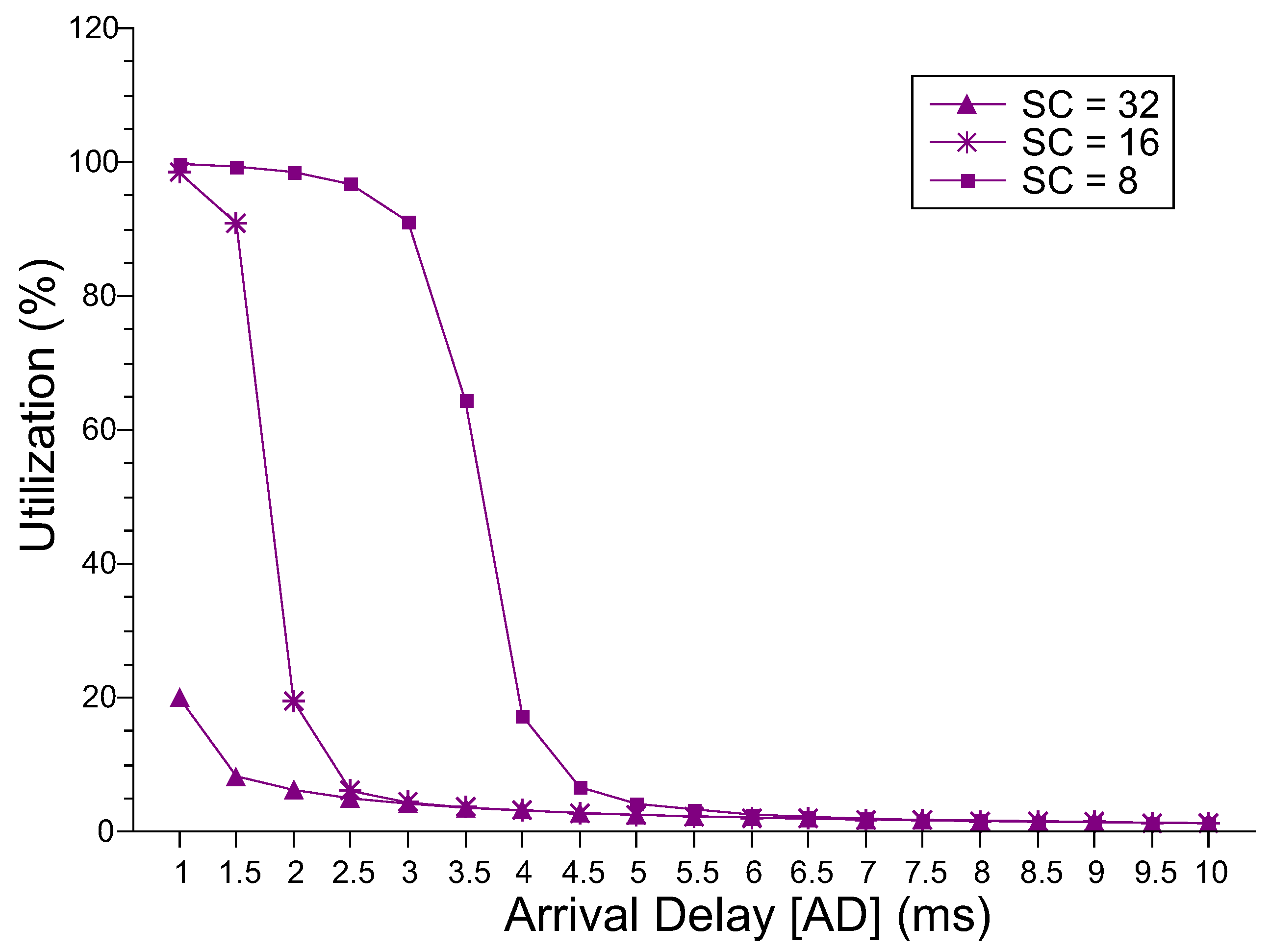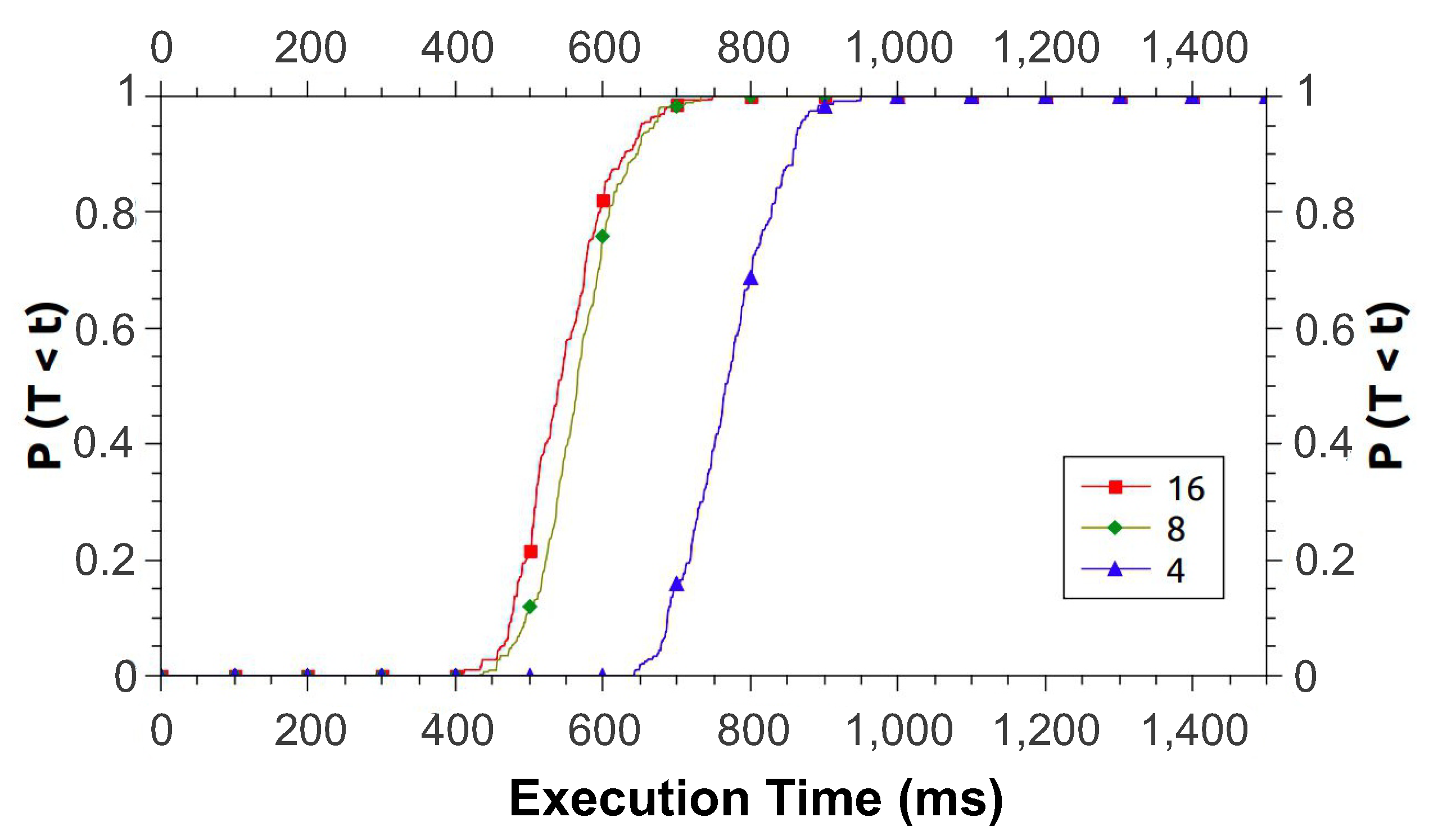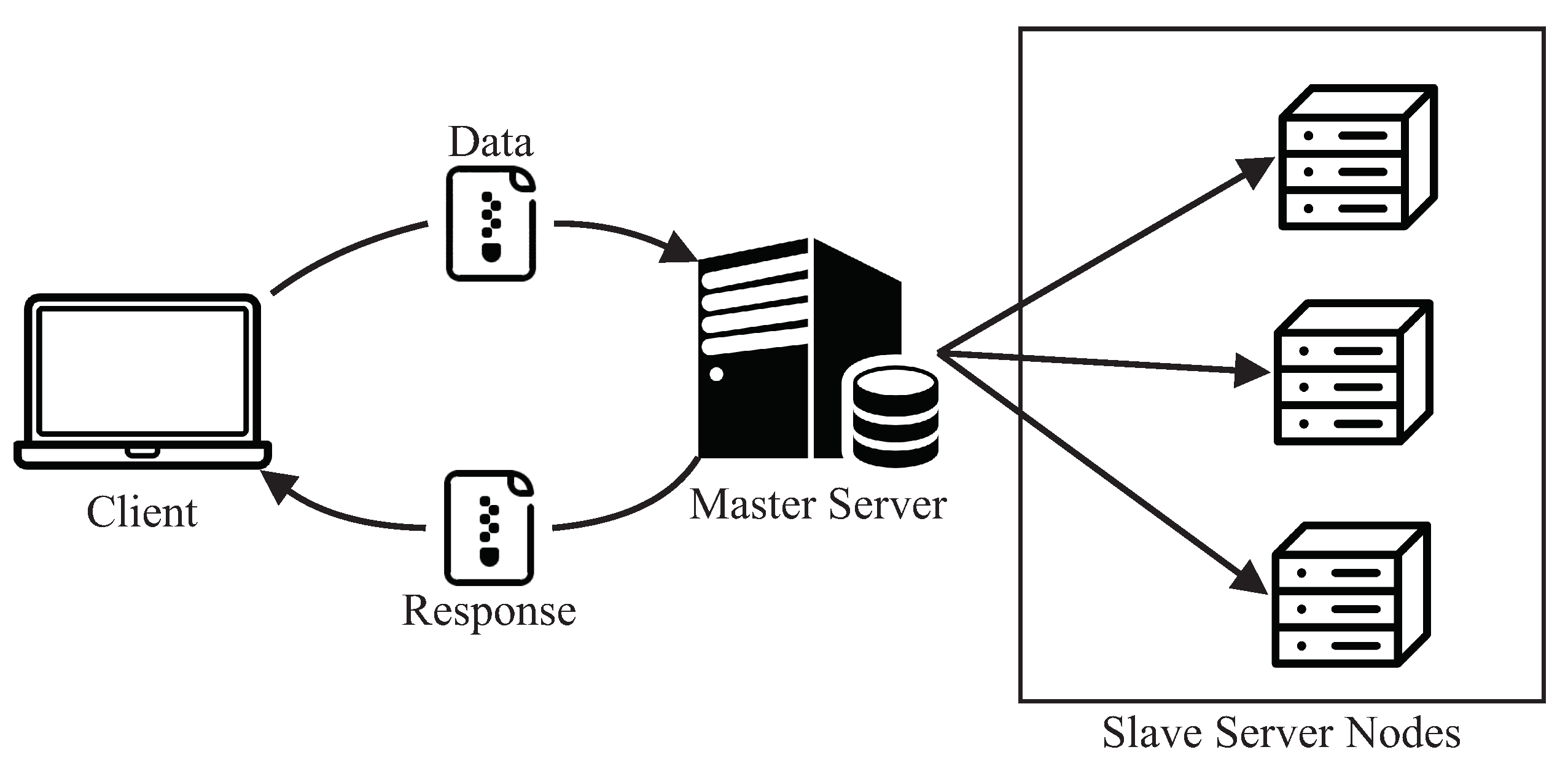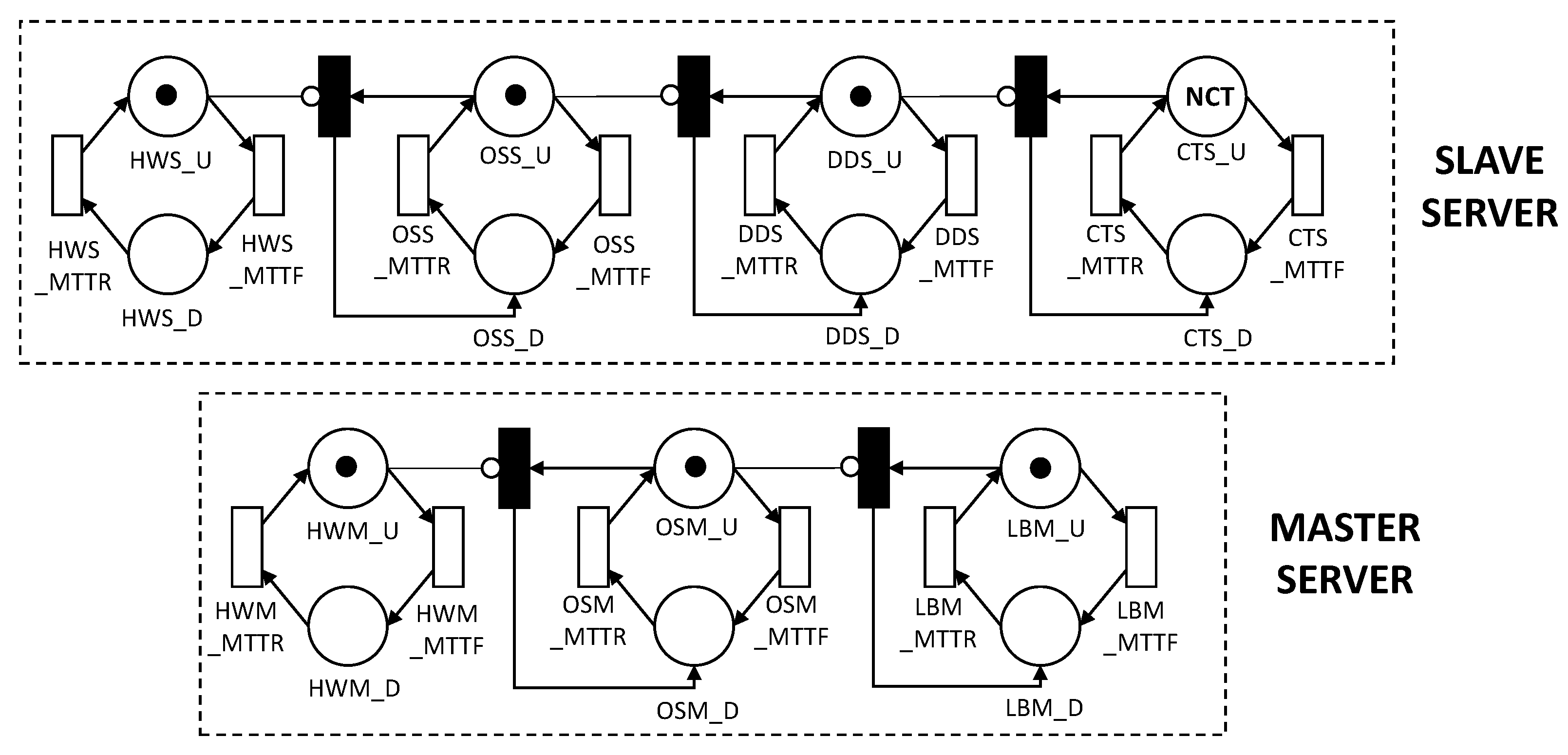This section presents two models for evaluating the performance of MEC architecture. In addition to the models, their respective case studies, metrics, and validation will be presented.
All the evaluations, including performance and availability models, were solved by numerical analysis. Usually, the numerical analysis is preferred instead of simulation because it offers a greater accuracy in the results [
37]. Therefore, the evaluator must try first the possibility of using numerical analysis but sometimes it is not possible. Petri Nets and Markov Chains can present the problem known as “state-space explosion” if the model is too big. In our case, fortunately the model can be solved by numerical analysis.
4.1. Basic SPN Model for MEC Architectures
In this section, we describe our SPN model to represent the architecture that integrates modules at the edge of the network, presented in the previous section. We emphasize that the purpose of our model is to make it possible to evaluate system performance, even before they are implemented.
Figure 3 presents our SPN model, composed of two macro parts:
Admission, which deals with the generation of requests;
Edge, composed of the master server and the server with slave nodes. The master server receives data and distributes it between slaves, which ultimately return the results to clients.
In an SPN model, fundamental graphical elements are used to represent system components, for instance, empty circles, filled circles, and empty bars represent places, place markings, and places in SPN model, respectively. The model elements are all described in
Table 2. Probability distributions are associated with timed transitions in the SPN model to capture the sojourn time of an event. To associate different probability distributions, the person in charge of system administration needs to investigate in the literature or conduct experimental measurements/characterizations of the system.
The description of the model and its flow of data processing throughout its components is as follows. Two places, P_Arrival and P_InputQueue, in the Admission sub-net capture the waiting behaviors between the generation and the acceptance of requests in the queue, respectively. Tokens which reside in the two places, P_Arrival and P_InputQueue, represent the involvement of data entry for any type of requests. The transition AD is used to capture the time between request arrivals. AD means arrival delay. We assume that times between arrivals comply with exponential distribution. However, this assumption is possibly relaxed considering other type of probability distribution. The AD transition does not take into account network losses.
As soon as T0 is enabled, requests arrive at the Edge sub-net. The queuing and amount of requests on edge are represented by the deposit and the number of tokens in P_MasterInProcess. The MC mark in P_MasterCapacity indicates the amount of temporary storage space of the master server, queuing the requests. In the case that capacity for processing requests in the master and slave is not sufficient for newly arrived requests, those requests are continuously queued. Thus, shortly after an amount of storage space is released, a token from P_InputQueue and P_MasterCapacity each is taken out and then deposited in P_MasterInProcess. When this happens, the place P_Arrival is then enabled, allowing a new arrival.
DD firing represents the beginning of the distribution of requests to the slaves. DD means distribution delay. These firings are conditioned to the amount of available nodes for processing in P_SlavesCapacity (with SC mark). The SC tag indicates the number of available nodes at the network edge. In the case that requests are under processing by slaves represented by tokens in P_SlavesInProcess, the tokens go out from P_SlavesCapacity. This flow means that an amount of the resource will be allocated to each arriving request.
PD represents the time spent by the slave node to process a request. When PD is fired, a token is pulled from P_SlavesInProcess, and a token is returned to P_SlavesCapacity. The AD transition has an exponential distribution since we are considering exponentially distributed arrival rates. The infinite server semantics are associated with all other transitions so that the processing of each job is independent to each other. It is worth noting that the computational capacity of each node causes an impact on the processing time. Nevertheless, we assume in this work that same computational capacity is given to all nodes in each layer.
A vast number of different scenarios can be evaluated using the proposed model, because the evaluator needs to configure five parameters as shown in
Table 2. The parameters include three timed transitions and the two place-related resource or workload markings. A certain change in the value of any parameter causes a significant impact on various performance metrics such as discard level, MRT, or resource utilization. The capability to investigate the variation of different scenarios and/or a number of impacting factors makes the proposed model a main contribution of this study.
4.1.1. Performance Metrics
Performance metrics are presented in this section, which are used to evaluate the performance of the edge architecture based on its proposed SPN model. The MRT is computed by adopting the Little’s law [
38]. Little’s law takes into account the number of ongoing requests in a system (
)—mean system size, the arrival rate of new requests (
), and the MRT. The arrival rate is the inverse of the arrival delay—that is,
. A stable system is required to compute metrics based on Little’s law. It means that the arrival rate must be lower or equal than the server processing rate. We assume that the actual arrival rate can be different with the effective one, or discarded due to finite queue size. Then, to obtain the effective arrival rate, we multiply the arrival rate (
) by the probability for the system to accept new requests (
) [
39]. Therefore, Equation (
1) obtains
considering Little’s law and the effective arrival rate.
Equation (
2) obtains
. To compute the number of ongoing requests in the system, the analyst must compute the sum of the expected number of tokens, which is deposited in each place representing ongoing requests. In Equation (
2),
represents the statistical expectation of tokens in the “Place”, where
. In other words,
indicates the expected mean number of tokens in that place.
Equation (
3) defines
. There must be one token in the input queue (P_ArrivalQueue), and there must be no more resources available to process new requests both in the master and slave nodes.
computes the probability of
n tokens in that “Place”.
Finally, in addition to
MRT, we also calculate resource utilization. Equation (
4) gives us the utilization of the master node. Equation (
5) gives us the utilization of the slave nodes. The utilization is obtained by dividing the number of tokens of the corresponding place by the capacity of the total resources.
4.1.2. Numerical Analysis
This section presents two numerical analyzes for MRT, discard, and utilization evaluations. In [
40], the authors evaluated a MEC architecture with a single mobile device as a client and containers executing the services. Authors have evaluated a 3D game called Neverball, where the player must tilt the floor to control the ball to collect coins and reach an exit point before the time runs out. We have considered the system parameters in [
40] as input parameters for our model. Therefore, our study evolves the work in [
40] by performing numerical analysis to evaluate the scenarios considering multiple parameters. We have considered one of their scenarios with a game resolution of 800 × 600 pixels. The adopted parameter value corresponding to the processing delay (PD) of a request is 24 ms. We adopted 5 ms as the time for distributing the requests in the system (DD transition). We established that the master server has a restriction regarding the maximum number of requests that may be simultaneously processed. This number corresponds to 40 requests—that is, MC = 40.
The model allows a wide variety of parameterizations. In the present analysis, we vary two parameters: the time interval between requests arrivals (AD) and the resource capacity of the server with slave (SC) nodes. The value of AD was varied between 1 ms and 10 ms, considering a step size of 0.5 ms. The SC variable was configured with three possibilities (8, 16, and 32), corresponding to the number of cores in a server. All these parameters could be varied in other ways. For example, the number of slaves could not be tied to the number of cores—SC could store thousands of tokens. Adopting the parameters mentioned above, we present the results considering MRT, discard, and utilization of the master server and slave servers.
Figure 4 shows the results for the MRT. At first, it is expected that the larger the time interval between arrivals (AD), the smaller the MRT. The system will be more able to handle the incoming requests with the available processing resources. It is also expected that the higher the slave’s capacity (SC), the lower the MRT because more processing capacity is available to handle the requests. These two behaviors are easily observed when the values of discards are minimal in the model (which can be observed in Figure 7). For minimal discards, the MRT decreases until the minimum time to perform requests without requests waiting in the queue.
However, when the system discards incoming requests, we observe the increase of the MRT until a peak, decreasing after that. This behavior is due to the limiting value of resources in the system, where some of the incoming requests are discarded when there are no more resources available to process them. Thus, limiting the MRT variation to the time between arrivals. As can be deduced from Little’s law [
39], the mean time between exits will increase along with the mean time between arrivals until to reach the peak. In our numeric results, the peaks were: for SC = 8 was in AD = 1.5 ms and for SC = 16 it was AD = 3.0 ms. At these points, the amount of work within the system begins to reduce, reducing MRT even when AD increases drastically. It is important to emphasize that in MRT, we consider the effective arrival rate, that is, adjusting its value by considering the discard probability.
The MRT for SC = 32 is low, even for a time interval between arrivals of 1 ms. Comparing SC = 16 and SC = 32, and considering an arrival delay of 2.5 ms, the MRTs equalize. Considering an arrival delay of 5.5 ms, and the SC = 8, it also presents the same average result. Therefore, if the real context has had an AD = 5.5 ms, an 8-core server would achieve the same performance as more powerful servers. Therefore, our work may assist managers in the task of choosing servers and identifying the best performance and costs, considering the expected workload.
Figure 5 shows the level of utilization of the master server. The master server is the first component that the request reaches upon entering the MEC layer. For the SC = 8 and SC = 16 configurations, the utilization level is around 100% in the lowest AD values; after that, utilization drops. For SC = 32, even with AD = 1.0 ms, the utilization value reaches only 20%. From AD = 5.5 ms, the three configurations have values similar to and close to 0%. The system administrator must consider the desire for high or low idle server levels.
Figure 6 shows the level of utilization of the slave servers. The higher the number of resources, the lower the level of utilization of the slaves. As AD increases, the level of utilization declines subtly in all three cases. However, this fall only starts at AD = 3.0 ms for SC = 8 and at AD = 1.5 ms for SC = 16. Up to these points, the utilization level is around 82%, which causes the behavior of the MRT explained above.
Figure 7 presents the probability of discarding new requests. For SC = 32, the discard probability is equal to 0. Therefore, if it is possible to acquire a server with 32 cores, there will be no discarding independent of the interval between request arrivals. For SC = 8 and SC = 16, only from AD = 2.0 ms and AD = 4.0, the discard probabilities tend to 0. These initial discard intervals are directly related to the high level of utilization presented by both servers, directly impacting the MRT. Therefore, any stochastic analysis performed with the proposed model must observe the four metrics to obtain a complete view of the system behavior. It is also possible to identify the operating limits of the system. In other words, these limits represent how many jobs can be lost without compromising the utility of the system.
4.2. Refined Model with Absorbing State
System administrators who want to use a MEC architecture should be aware of when their applications are most likely to finish execution. Cumulative Distribution Functions (CDFs) may indicate such a moment through the maximum probability of absorption. CDFs are associated with a specific probability distribution. In this work, the probability distribution is related to the probability of finishing the application execution within a specified time. It is obtained through transient evaluation, generating probabilities with time tending to one value t. In other words, developers compute the probability of absorption in [0, t), through transient evaluation, where F (t) approaches 1.
CDFs indicate the maximum probability of an application’s processing to be completed within a given time interval. In this work, the absorbing state is reached when the model is in the FINISH state. For a better understanding of time-dependent metrics, it is necessary to define the difference between transient state and absorbing one. Transient states are defined as temporary states. In other words, when the system leaves a transient state, there is a likelihood of never coming back to it again. On the other hand, an absorbing state is a state that when the system reaches it, there is no way out.
Figure 8 shows the adaptation we made in our SPN model presented previously to calculate CDFs.
Three changes were made: (a) an absorbing state place (named Finish) was added in the right part of the model, indicating that when the requests reach this place, such requests will not change state; (b) in the Admission block, the feedback loop () has been withdrawn, indicating that new requests will not be generated unmistakably; and (c) there is a new parameter called BATCH (at place P_Arrival) that represents the number of jobs (tokens) that will be processed. The CDF calculates the probability of these jobs to complete the application processing at a given time and in a specific time interval.
4.2.1. Case Study 1
For this study, we set the master server capacity (MASTERC) as 40, the time between arrivals (AD) to 5 ms, and we created three scenarios by varying the server capacity with the slave nodes (SLAVEC) as 8, 16, and 32. These scenarios have been defined in order to verify which slave server configuration best meets the requirements of an infrastructure administrator, according to the total time desired for the application execution.
Table 3 allows a better view of these variables.
Figure 9 shows the results obtained for CDF. In general, scenario #1 is the one that takes the longest time to run the application. Note that the scenarios #2 and #3 are the best cases, and with performance levels close to each other. Despite some occurrences where scenario #3 fares better than #2, when the probability of execution ends near 1, the times balance out. We can also see that both scenarios have an execution time in which the probability increases intensely. Assuming that an infrastructure administrator wants their application to complete within 800 ms, this can be accomplished using scenarios #2 and #3, and a choice can be made based on resource availability.
4.2.2. Case Study 2
For this study, we set the master server (MASTERC) capacity to 40, the slave server capacity to 16 nodes, and create some scenarios ranging from arrival time (AD) with values between 1 ms to 10 ms, with 1 ms increments.
Table 4 presents the combination of these variables.
Figure 10 presents the results obtained for the CDF metric. The application execution time increases with the increase of AD. In this study, we have a batch of 100 requests. Each of these requests enters the model according to the interval defined in AD. Thus, for AD equal to 1 ms, we know that the minimum application execution time is 100 ms, while for AD equal to 10 ms, the minimum execution time is 1000 ms. We can also see that both scenarios have an execution time where the probability increases intensely; however, this increasing aspect slightly decreases as AD grows. Assuming an infrastructure administrator wants their application to run within 700 ms, the model ensures that this can be achieved with #1, #2, #3, or #4 scenarios.
4.2.3. Model Validation
The validation of the proposed system SPN model is detailed in this section. We performed different experiments in practical scenarios to measure the system’s MRT and then compare with the MRT computed by the proposed model for the sake of validation. An experimental laboratory test-bed (as shown in
Figure 11) was developed to help validate the analysis results of the proposed model, which has the following configuration, (i) internet bandwidth at 40 Mbps, (ii) a computer for synthetic request generation with CPU of Intel Core i7 2.4 Ghz and RAM of 8 GB capacity.
We adopted a well-known word processing algorithm (Word Count Algorithm
https://tinyurl.com/y8hofs5x, accessed on 10 November 2020) using MapReduce for big data processing. The algorithm can help compute the number of keywords in a text file upon their unique occurrences. The texts in the file are split into data blocks. The number of
splits determines the number of mapping steps for split jobs. Afterwards, all split tasks are allocated and distributed to slave nodes. This process generates key-value pairs in which a key is mapped to a specific word while the key’s value is exactly the number
1. It is worth noting that, the mapping results do not imply the accumulated occurrences of words in a text file. The sorting process generates a list of all values by key, after that, the reducing process summarizes the occurrences of each key in the list to obtain the total number of each keywords. Finally, the reducing process creates a file consisting of the number of occurrences in the text file for each word. In experimental implementation, the execution of the mapping and reducing processes is allocated to each node. At the end, the processing time of a text file at 15 MB size is measured on a single node, and the measured output is used to feed to model parameters.
We deployed the edge into four different machines—one master and three other slave nodes. The arrival rate of a new request is set to the value 230 s. Each request is to process three consecutive text files at 40 MB in size each. To comply with Little’s law, the processing tasks are allocated to machines in the way that each machine processes only one file at a time. In this way, the experiment can obtain the highest level of parallelism without stressing the computer system. The mean processing time of one file on a slave node (PD) is necessarily measured in order to feed to parameters in the proposed model. The values of parameters in the SPN model used for model validation are summarized as follows, (i) PD: 51.7 s, (ii) AD: 230 s, (iii) MC: 20 and (iv) SC: 3. Using stationary analysis for the SPN model, the calculated value of MRT was 86.74 s. Furthermore, the value of total resource utilization was 22.4%.
The experiment is conducted by repeatedly dispatching a specific number of consecutive requests (
100 requests) to the edge. The extracted sample showed a normal distribution with a mean of 86.906 s. The One-Sample
t-Test (One Sample
t-Test
https://tinyurl.com/yanthw4e, accessed on 20 November 2020) is used to make inferences about a population mean, based on data from a random sample. One-Sample
t-Test is adopted to compare the values of MRT which are generated by the model and by the sample mean, respectively. It should be pointed out that, the case which both means are equal falls in the null hypothesis. The test results are (i) mean: 86.91 s, (ii) standard deviation: 5.039, (iii) standard error mean: 0.504, (iv) 95% confidence interval: (85.906, 87.905), (v) T: 0.41, (vi)
p-value: 0.684.
As per observed, it is not possible to disprove the null hypothesis with 95% confidence due to the reason that the p-value is bigger than the number 0.05, according to statistics. As per examined, we noticed a statistical equivalence between the generated results of the proposed SPN model and the measured results of test-bed experiments. At this level, the proposed model is practically appropriate for expansion in performance evaluation of real-world big-scale edge computing infrastructures. The proposed model literally represents an actual environment and computing system, and thus, it can be used for planning and assessment in the development of MEC infrastructures.




























